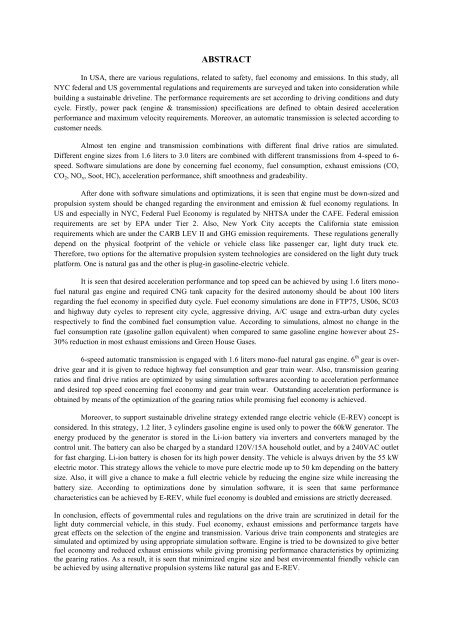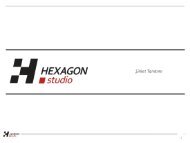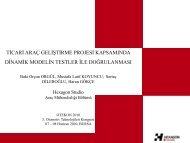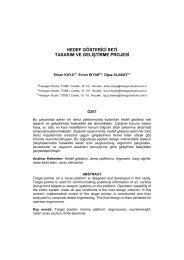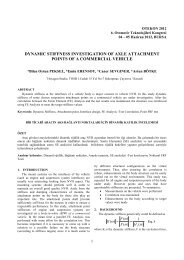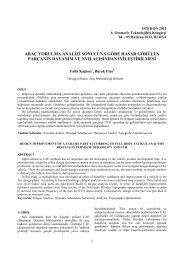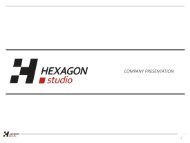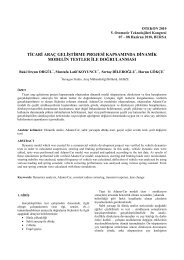ABSTRACT - Hexagon Studio
ABSTRACT - Hexagon Studio
ABSTRACT - Hexagon Studio
You also want an ePaper? Increase the reach of your titles
YUMPU automatically turns print PDFs into web optimized ePapers that Google loves.
<strong>ABSTRACT</strong><br />
In USA, there are various regulations, related to safety, fuel economy and emissions. In this study, all<br />
NYC federal and US governmental regulations and requirements are surveyed and taken into consideration while<br />
building a sustainable driveline. The performance requirements are set according to driving conditions and duty<br />
cycle. Firstly, power pack (engine & transmission) specifications are defined to obtain desired acceleration<br />
performance and maximum velocity requirements. Moreover, an automatic transmission is selected according to<br />
customer needs.<br />
Almost ten engine and transmission combinations with different final drive ratios are simulated.<br />
Different engine sizes from 1.6 liters to 3.0 liters are combined with different transmissions from 4-speed to 6-<br />
speed. Software simulations are done by concerning fuel economy, fuel consumption, exhaust emissions (CO,<br />
CO 2 , NO x , Soot, HC), acceleration performance, shift smoothness and gradeability.<br />
After done with software simulations and optimizations, it is seen that engine must be down-sized and<br />
propulsion system should be changed regarding the environment and emission & fuel economy regulations. In<br />
US and especially in NYC, Federal Fuel Economy is regulated by NHTSA under the CAFE. Federal emission<br />
requirements are set by EPA under Tier 2. Also, New York City accepts the California state emission<br />
requirements which are under the CARB LEV II and GHG emission requirements. These regulations generally<br />
depend on the physical footprint of the vehicle or vehicle class like passenger car, light duty truck etc.<br />
Therefore, two options for the alternative propulsion system technologies are considered on the light duty truck<br />
platform. One is natural gas and the other is plug-in gasoline-electric vehicle.<br />
It is seen that desired acceleration performance and top speed can be achieved by using 1.6 liters monofuel<br />
natural gas engine and required CNG tank capacity for the desired autonomy should be about 100 liters<br />
regarding the fuel economy in specified duty cycle. Fuel economy simulations are done in FTP75, US06, SC03<br />
and highway duty cycles to represent city cycle, aggressive driving, A/C usage and extra-urban duty cycles<br />
respectively to find the combined fuel consumption value. According to simulations, almost no change in the<br />
fuel consumption rate (gasoline gallon equivalent) when compared to same gasoline engine however about 25-<br />
30% reduction in most exhaust emissions and Green House Gases.<br />
6-speed automatic transmission is engaged with 1.6 liters mono-fuel natural gas engine. 6 th gear is overdrive<br />
gear and it is given to reduce highway fuel consumption and gear train wear. Also, transmission gearing<br />
ratios and final drive ratios are optimized by using simulation softwares according to acceleration performance<br />
and desired top speed concerning fuel economy and gear train wear. Outstanding acceleration performance is<br />
obtained by means of the optimization of the gearing ratios while promising fuel economy is achieved.<br />
Moreover, to support sustainable driveline strategy extended range electric vehicle (E-REV) concept is<br />
considered. In this strategy, 1.2 liter, 3 cylinders gasoline engine is used only to power the 60kW generator. The<br />
energy produced by the generator is stored in the Li-ion battery via inverters and converters managed by the<br />
control unit. The battery can also be charged by a standard 120V/15A household outlet, and by a 240VAC outlet<br />
for fast charging. Li-ion battery is chosen for its high power density. The vehicle is always driven by the 55 kW<br />
electric motor. This strategy allows the vehicle to move pure electric mode up to 50 km depending on the battery<br />
size. Also, it will give a chance to make a full electric vehicle by reducing the engine size while increasing the<br />
battery size. According to optimizations done by simulation software, it is seen that same performance<br />
characteristics can be achieved by E-REV, while fuel economy is doubled and emissions are strictly decreased.<br />
In conclusion, effects of governmental rules and regulations on the drive train are scrutinized in detail for the<br />
light duty commercial vehicle, in this study. Fuel economy, exhaust emissions and performance targets have<br />
great effects on the selection of the engine and transmission. Various drive train components and strategies are<br />
simulated and optimized by using appropriate simulation software. Engine is tried to be downsized to give better<br />
fuel economy and reduced exhaust emissions while giving promising performance characteristics by optimizing<br />
the gearing ratios. As a result, it is seen that minimized engine size and best environmental friendly vehicle can<br />
be achieved by using alternative propulsion systems like natural gas and E-REV.
Title<br />
“A case study in the development of sustainable vehicle driveline strategies – NYC ToT*”<br />
Four Subtitles<br />
Regarding the environment and emission & fuel economy regulations<br />
Downsizing the engine for the light commercial vehicle applications and duty cycle requirements<br />
Optimizing the gear train ratios to obtain outstanding acceleration performance while giving promising<br />
fuel economy<br />
Setting an alternative driveline concepts for the NYC ToT (natural gas-E-REV**)<br />
* New York City Taxi of Tomorrow<br />
** Extended Range Electric Vehicle<br />
Related Topics<br />
Transmission and Drive train requirements<br />
Environment-friendly drives: Downsizing and alternative drives for cars, commercial vehicles and all<br />
wheel-drive vehicles


